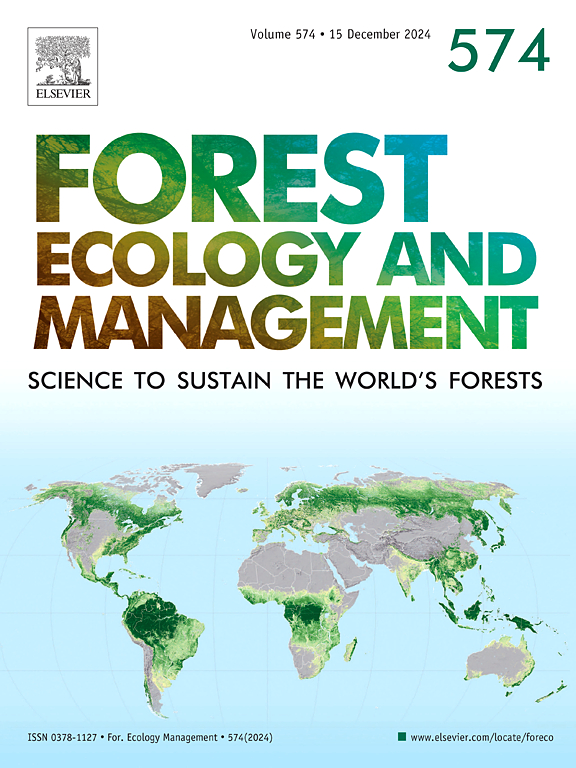回收采伐对挪威云杉枯死后欧洲温带森林土壤小气候的影响
IF 3.7
2区 农林科学
Q1 FORESTRY
引用次数: 0
摘要
在大多数管理森林中,回收采伐是在受到干扰后恢复森林自然和经济资本的常用方法。然而,在管理目标和打捞性采伐的生态影响之间的权衡可以影响其他森林恢复决策。在2018年挪威云杉(Picea abies)枯死事件发生后,我们监测了土壤温度和土壤含水量,这两个都是关键的土壤小气候变量,以评估三种常用的干扰后处理的影响:立即救助性伐木(<;2年),延迟打捞采伐(3-4年),不打捞采伐。即时采伐对土壤温度变量的负面影响最大,表层土壤(10 cm)白天最高温度升高3.5°C,日温度变化升高1.9°C。底土层(30和60 cm)也有明显的增加。然而,延长干扰和伐木之间的时间,减轻了这些对土壤温度稳定性的负面影响,提供的土壤小气候读数与没有采伐和/或干扰前的条件相似。此外,延迟补救性采伐或选择不补救性采伐,与对照相比,土壤含水量增加了8 - 11% %。这些结果表明,推迟大约3-4年的补偿性采伐可以显著减少对土壤小气候的负面生态影响,并增强温带森林面对气候变化下潜在的大规模干扰的恢复能力。本文章由计算机程序翻译,如有差异,请以英文原文为准。
Effects of salvage logging on the soil microclimate of temperate European forests following Norway spruce dieback
In most managed forests, salvage logging is a common method of regaining forest natural and economic capital following disturbances. Nevertheless, trade-offs between management objectives and the ecological impacts of salvage logging can influence other forest restoration decisions. Following an episode of Norway spruce (Picea abies) dieback in 2018, we monitored soil temperature and soil water content, both key soil microclimate variables, to assess the impact of three commonly used post-disturbance treatments: immediate salvage logging (< 2 years), delayed salvage logging (3–4 years), and no salvage logging. Immediate logging had the greatest negative impact on soil temperature variables, with maximum daytime soil temperatures increasing by up to 3.5°C in the topsoil (10 cm) and diurnal temperature variation rising by up to 1.9°C. Increases were also evident in the subsoil layers (30 and 60 cm). Prolonging the time between disturbance and logging, however, mitigated these negative effects on soil temperature stability, providing soil microclimate readings similar to those at sites with no salvage logging and/or pre-disturbance conditions. In addition, delaying salvage logging, or opting for no salvage logging, resulted in an 8–11 % increase in soil water content compared to the control. These findings suggest that postponing salvage logging by approximately 3–4 years significantly reduces negative ecological impacts on soil microclimate and enhances the resilience of temperate forests in the face of potential large-scale disturbances under climate change.
求助全文
通过发布文献求助,成功后即可免费获取论文全文。
去求助
来源期刊

Forest Ecology and Management
农林科学-林学
CiteScore
7.50
自引率
10.80%
发文量
665
审稿时长
39 days
期刊介绍:
Forest Ecology and Management publishes scientific articles linking forest ecology with forest management, focusing on the application of biological, ecological and social knowledge to the management and conservation of plantations and natural forests. The scope of the journal includes all forest ecosystems of the world.
A peer-review process ensures the quality and international interest of the manuscripts accepted for publication. The journal encourages communication between scientists in disparate fields who share a common interest in ecology and forest management, bridging the gap between research workers and forest managers.
We encourage submission of papers that will have the strongest interest and value to the Journal''s international readership. Some key features of papers with strong interest include:
1. Clear connections between the ecology and management of forests;
2. Novel ideas or approaches to important challenges in forest ecology and management;
3. Studies that address a population of interest beyond the scale of single research sites, Three key points in the design of forest experiments, Forest Ecology and Management 255 (2008) 2022-2023);
4. Review Articles on timely, important topics. Authors are welcome to contact one of the editors to discuss the suitability of a potential review manuscript.
The Journal encourages proposals for special issues examining important areas of forest ecology and management. Potential guest editors should contact any of the Editors to begin discussions about topics, potential papers, and other details.
 求助内容:
求助内容: 应助结果提醒方式:
应助结果提醒方式:


